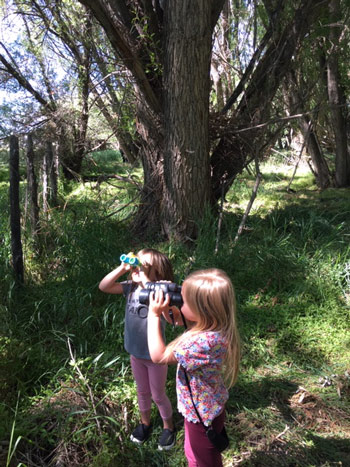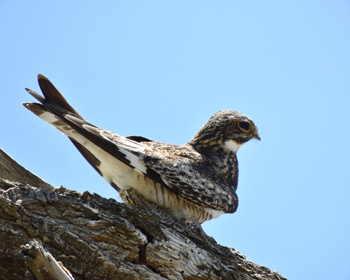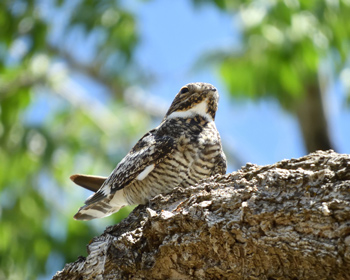|
July 2020
Contents
Monthly Meeting
Upcoming Field Trips
President's Message
Bird of the Month
Field Trip Reports
JULY MEETING:
UCB Meetings continue to be postponed for now as we monitor
COVID-19 conditions and recommendations. We encourage everyone to go birding
while taking appropriate precautions and following current social distancing
guidance. We generally have field trips in place of meetings during the summer
and hope to continue with those and with our tradition of having a potluck for
our August meeting. We wish you healthy and happy birding!
In place of a meeting, you can introduce a new person (family
member or friend) to birding. You can choose a good day and a fun route.
FIELD TRIPS:
Enjoy birding on your own, maintaining the social distancing and
guidelines issued by the governor of Utah.
President's Message -
June 2020
by Machelle JohnsonWe
are half way through this 'Challenging' year. How is the Birding Challenge going
for you? I'm finding that some of the options that I thought would be 'easy' to
do are turning out to be, well, challenging. In part it is due to this pandemic
that is still going on. We would typically be using field trips to go to the
lakes and reservoirs, state parks and national forests, and having experts on
hand and several sets of eyes on the lookout! Hopefully we will get back to that
soon! In the meantime, I hope you are able to get out and about.
For the June meeting we were asked to introduce a new
person to birding. My young granddaughters call me Grandma Hootie, or just
Hootie, and know that I love birds.
|
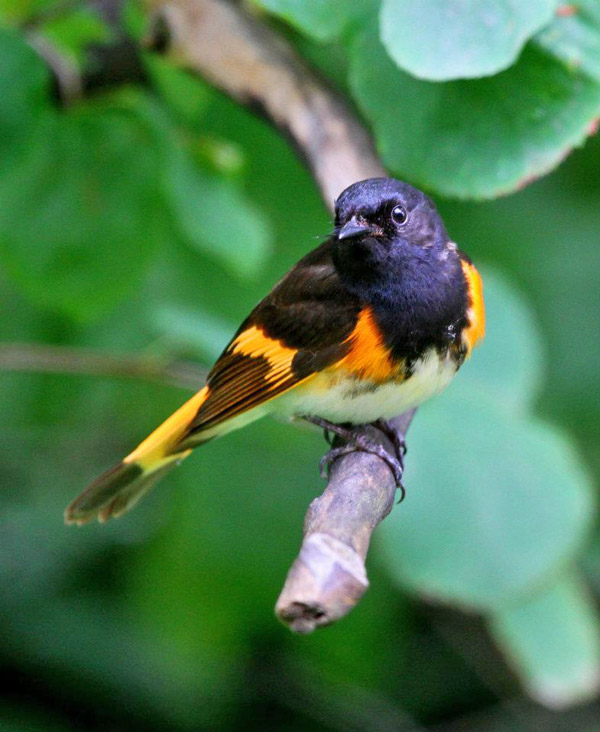
American Redstart
by Eric Peterson
©Eric
Peterson |
They always want to go with me, so I took them out when
I went to see the American Redstart in Saratoga Springs. As we were
walking down the trail I was telling them that we needed to listen to hear the
birds singing, and to watch for birds flying around. These girls are 4 and
3...as soon as I said 'singing', they started singing...both of them, each
singing different songs. Needless to say, they are quite young to grasp the
birding concept, but we did have a lot of fun. We did find the Redstart, and we
had a cooperative Western Wood Pewee actively fly-catching, landing on a
low branch near the trail. We were able to watch that for a bit and the girls
really liked seeing it so close. They started noticing more and more as we
walked on. It was fun to spend that time with them on a nice afternoon, enjoying
nature, which is what birding is all about to me.
We're in the summer months now, spring migration is over. I hope you were able
to see the very accommodating White-rumped Sandpiper at Lincoln Beach, the also
very accommodating American Redstart and not so accommodating Eastern Phoebe in
Saratoga Springs, and some of the other migrants that have been moving through.
It's getting hot now, time to head for the higher elevations to see some of my
favorites, Pine Grosbeak, Canada Jay, Clarks Nutcracker and Red Crossbill to
name a few. The Alpine Loop, Nebo Loop and Mirror Lake/Uintah's are accessible
now. Grab your sunscreen and bug-spray and head out! I hope to see you out
there!
|
|
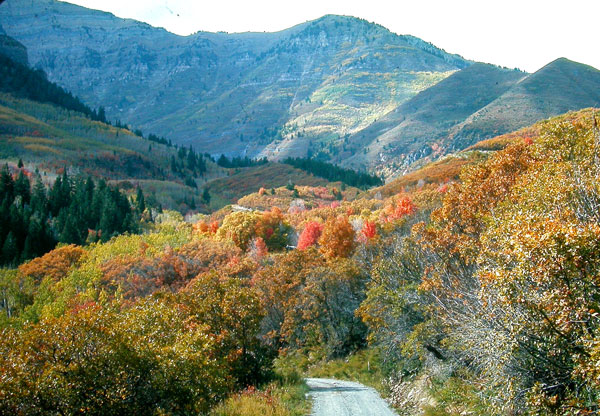
Alpine Loop
by Merrill Webb
©Merrill Webb |
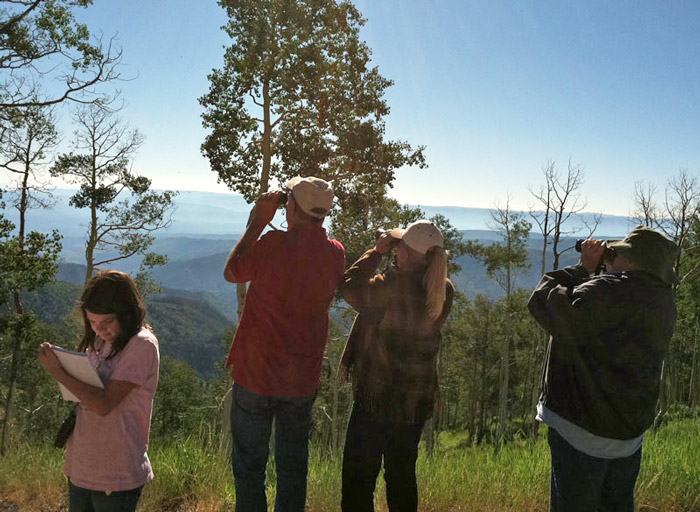
Nebo Loop
by Eric Huish
©Eric Huish |
|
|
|

Our newest Utah County Birder!
4 Generation birding here we come!!
Amanda and Izzy and Gramma and Gramps
couldn't be any happier.
We are all so excited.
Our
little "TNT"
Tatum Nox Tinoco is here!
June 28, 2020
8:53 pm
9 lbs. 1 oz.
21inches
|
|
|
|
|
Congratulations! ...to Suzi Holt and her growing family!
|
|
|
Special Article:
|
|
The Origins of Bird Watching
and Bird Societies
by Keeli Marvel
|
Did you know? Bird
watching, or birding as we now refer to it, likely began as a hobby of the upper
class - something only those with leisure time could afford to do. While
historical records indicate bird observations occurred prior to the 19th
century, that is really when it became a common gentleman's past time. Bird
watchers began with collecting, and collectors would shoot birds in order to
identify them in hand. With the invention of the prism lenses by the Carl Zeiss
company in the 1890s, shooting was no longer necessary and binoculars started
becoming available as a tool for field bird identification.
In the late 1800s bird feathers were popularly used as decorative items in hats
and clothing, and several bird species in the U.S., such as Snowy Egret, were in
danger of being hunted to extinction because the demand was so great. In 1896
Harriet Hemenway and Minna B. Hall recognized that several bird species were in
danger of being wiped out and founded the first Audubon society, the
Massachusetts Audubon. It was named in honor of John James Audubon, a naturalist
and artist who made a name for himself in the early 1800s by publishing a book
of life-sized prints of 435 species of American birds titled "Birds of America."
He also conducted some of the first bird banding experiments, tying string
around Eastern Pheobes' legs and learning that they returned to the same nesting
sites year after year. Within two years of the establishment of the
Massachusetts Audubon Society 16 other states had formed their own chapters. In
1905 the state Audubon organizations banded together to form a national Audubon
society with the mission of conserving bird species, and in 1918 President
Woodrow Wilson signed the Migratory Bird Treaty Act (MBTA), which to this day
protects wild North American bird species.
In 1900, Audubon member Frank M. Chapman started the first Christmas Bird Count
as a substitute for a Christmas tradition called the side hunt where men would
compete to shoot as many birds and mammals as possible.
In 1934 the first field guide with illustrations by Roger Tory Peterson was
published, making birding more accessible and more popular than ever before.
Over the years the Audubon society has grown to over 450 local chapters and has
been instrumental in conserving birds in the U.S., including helping raise
awareness of the effects of DDT back in the 1960s, saving Bald Eagles from
near-extinction, and also lobbying for the creation of the Endangered Species
Act, among other pieces of legislation, that are responsible for efforts to save
species such as the California Condor. The Christmas Bird Count is now the
longest running bird survey in the world.
The creation of the Audubon society has also been instrumental in the foundation
of hundreds of birding organizations (such as our own), which gather like-minded
bird-loving people all over the world.
Happy Birding! |
|
|
|
|
BIRD OF THE MONTH:
|
|
Common Nighthawk
(Chordeiles minor)
by Kayla Echols
|
|
When you first hear the
name "nighthawk," you might imagine a predatory bird with sharp talons and a
hooked beak that hunts small animals in the night, a lot like an owl. However,
the Common Nighthawk is actually not a hawk at all! It belongs to a family of
birds called Caprimulgidae, also known as nightjars or "goatsuckers." But where
in the world did the name "goatsucker" come from?
The strange name can be traced back to an old superstition.
For many years, it was commonly thought that nighthawks, poorwills, and other
related birds would come into barns at night, suck milk from the udders of
female goats, and cause them to go blind and stop producing milk. Ornithologist
and field guide author David Sibley once said, "They [birds in the family
Caprimulgidae] all have tiny beaks that open to reveal an impressively large
mouth used to catch flying insects, and they are active mainly at night. Their
nocturnal habits made them mysterious, and their bizarre appearance required an
explanation."
Bizarre appearance is right! One of the best times to see Common Nighthawks in
the wild is at dawn or dusk, when they're active and flying but there's still
enough natural light in the sky to see them. At first glance, it's easy to
mistake nighthawks for very large bats, thanks to the erratic, darting way they
fly--chasing after airborne insects just like bats do. It's no wonder so many
people found them spooky!
One reason that Common Nighthawks are hard to see in the
daytime is their superb camouflage. They are covered in a cryptic pattern of
mottled shades of gray and brown that blends right into tree bark, and for the
most part they hold very still and don't attract much attention from their
napping spot on a branch. However, I recently had the good fortune to spot a
Common Nighthawk at Antelope Island State Park during the daytime after he flew
from one perch to another, announcing his presence with his buzzy "PEENT" call
as he went. I probably never would have seen him if he had just held still and
stayed quiet. But I'm glad he didn't! It was a real treat to get a good look at
a bird that's usually so sneaky.
So next time you're enjoying a summer evening outdoors as the heat of the day
fades away, keep your eyes and ears open--because you never know when a Common
Nighthawk might pay you a visit.
Sources:
-
All
About Birds "Common Nighthawk Life History" by Cornell University
-
"Why are they called goatsuckers?" by David Sibley:
- Photo credit: Kayla Echols, taken June 1, 2020 at Garr Ranch at
Antelope Island State Park
|
|
|
|
|
|
|
Utah Birds - Our Website Report
Recent Sightings of Unusual Birds:
(Click on photos).
Several hybrids and a
Black-headed Grosbeak with a bold white eye ring have been found
recently in Utah.
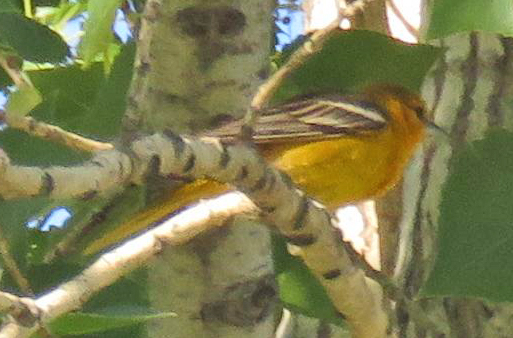 A female
Baltimore Oriole x
Bulock's Oriole hybrid has struck up a relationship with a male
Bullock's Oriole at the newly created Tracey
Aviary Jordan River Nature Center. Bryant Olsen sent in
photos of
this interesting bird that has the bright orange chest of a Baltimore and the
bright throat area of a Bullock's Oriole, plus other signs of hybridization. You
can read Bryant's sight
record for more details about this rare and interesting bird. A female
Baltimore Oriole x
Bulock's Oriole hybrid has struck up a relationship with a male
Bullock's Oriole at the newly created Tracey
Aviary Jordan River Nature Center. Bryant Olsen sent in
photos of
this interesting bird that has the bright orange chest of a Baltimore and the
bright throat area of a Bullock's Oriole, plus other signs of hybridization. You
can read Bryant's sight
record for more details about this rare and interesting bird.
 In
his backyard in Cedar City, Jim Bruce spotted a very strange-looking
Black-headed Grosbeak with spiffy white eye
rings. He sent photos into the Photo Gallery so we can enjoy this
interesting variation from the normal. If this ends up being a dominant
trait, we may have a different species developing before our eyes! If so ..... In
his backyard in Cedar City, Jim Bruce spotted a very strange-looking
Black-headed Grosbeak with spiffy white eye
rings. He sent photos into the Photo Gallery so we can enjoy this
interesting variation from the normal. If this ends up being a dominant
trait, we may have a different species developing before our eyes! If so .....
You can say you saw it here first!
 A
report from May of 2018, of a
Bendire's Thrasher
x Northern Mockingbird hybrid, seen in Washington County, has been
sent in by Mike Schijf. Although this type of hybrid has occurred
in captivity back in the late 1980' at the Arizona Sonora Desert Museum,
this may be the first of its kind documented in the wild.
(More interesting sightings can be found on our
Special
Sightings page). A
report from May of 2018, of a
Bendire's Thrasher
x Northern Mockingbird hybrid, seen in Washington County, has been
sent in by Mike Schijf. Although this type of hybrid has occurred
in captivity back in the late 1980' at the Arizona Sonora Desert Museum,
this may be the first of its kind documented in the wild.
(More interesting sightings can be found on our
Special
Sightings page).
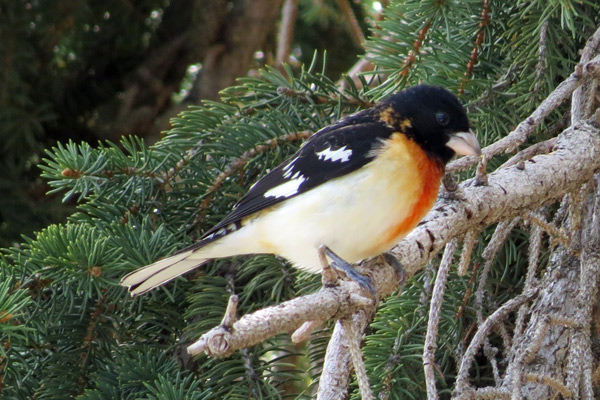 Photos of a
Rose-breasted x Black-headed Grosbeak hybrid found at the mouth of
Payson Canyon in May of last year, were sent
into the Photo Gallery by Cliff Miles. When you look at this bird, it
looks pretty familiar -- it's a pretty good blend of two
striking birds. The underside has the distinct pattern of the
Rose-breasted Grosbeak except for the rose color and the top looks very much
like our more familiar Black-headed Grosbeak.. Striking blend! Photos of a
Rose-breasted x Black-headed Grosbeak hybrid found at the mouth of
Payson Canyon in May of last year, were sent
into the Photo Gallery by Cliff Miles. When you look at this bird, it
looks pretty familiar -- it's a pretty good blend of two
striking birds. The underside has the distinct pattern of the
Rose-breasted Grosbeak except for the rose color and the top looks very much
like our more familiar Black-headed Grosbeak.. Striking blend! |
|
|
|
Field Trip Reports
(There are Individual Field Trip Reports on our
Facebook Page)
|
|
|
|

